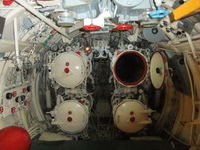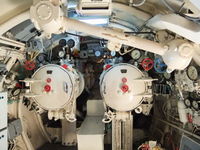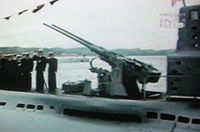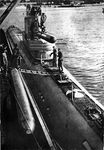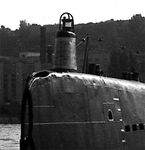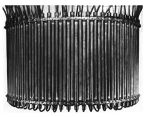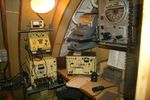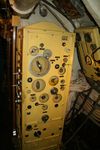Submarines of project 613

Contents
General information
The experience of World War II demonstrated the enormous role that submarines play in combat operations on the seas and in the oceans. The Soviet Union entered the war with USSR Navy only 218 submarines - almost half the size of the German submarine forces in 1943, at its peak: 432 boats. The new, this time Cold War, which began shortly after the end of the war, required a sharp increase in the number of submarines also because they constituted a significant part of the strike forces of the main geopolitical opponent Russia - USA.
History of creation
During the Second World War, it was obvious that the Shchuka_type submarines produced since the beginning of the 30s were outdated and could no longer effectively withstand enemy submarines in terms of diving depth, torpedo firing capabilities, and others. characteristics. A distant prototype of Project 613 submarines is Project 608 submarines, the development of which TsKB-18 began back in 1942. However, in 1944, the German submarine of the VII U-250 series was raised, which had TTD, close to the Project 608 submarine. In connection with this, People's Commissar of the USSR Navy N. G. Kuznetsov decided to stop work on project 608, until the study of the U-250 submarine. In 1945, almost all types of German boats became the trophy of the Soviet army - both the ships themselves and the working drawings. Soviet specialists were given the opportunity to observe the completion of German submarines in the Soviet zone of control.
Predecessors
Before the start of World War II, medium-sized submarines of two projects were serially built for the Soviet Navy: Pike (X bis series in construction 11 units) and C (IX bis 28 units). The first of them was the development of a well-established industry submarine of the III series, designed in 1930, which, despite all the improvements, is already hopelessly outdated. The serial construction of ships of the Pike type, along with much more advanced type C (German design, designer - Dr. Johann Techel), continued only because of the insufficient development of the industry by the construction of a large series of submarines of the German project. In this regard, the problem arose of developing a new project for a medium submarine to replace the Shchuka-type submarines (in 1941 there were 76 of them in service), since it seemed completely obvious that without fundamental changes in the shape and design of the hull, a further increase in the level of combat capabilities of submarine boats like Pike was impossible.
Prerequisites for creation
The Second World War demanded that the experience of Soviet and foreign submarine shipbuilding be carefully studied and taken into account when designing new submarines. In 1942, Soviet designers began work on a project for a new medium submarine designed to replace the aging Shchuka. The project received the number 608, but it did not come to its implementation in metal. In 1944, the German submarine U-250 series VIIC, sunk in shallow waters in the Gulf of Finland, became a Soviet trophy, which became a prototype for the construction of a Project 613 submarine. After the end of World War II, the Soviet army and engineers also began to search for documentation and submarine engineers throughout the Soviet controlled zone of Germany. A design office was found in Blankenburg working on Walter turbines. Engineers from this bureau began work on the construction of submarines under Soviet supervision. Many German factories that produced elements for the type XXI submarine at the most important shipyard Schiehau in Gdańsk. These factories contained many components of the XXI units, and the shipyard itself had a large number of unfinished ships (the already completed units from U-3538 to U-3542 were in the shipyard at the stage of final equipment). Type XXI submarine units, as well as the elements and materials used for their manufacture, were tested by a large number of Soviet research institutes and design bureaus.
Design
In 1939, the People's Commissariat of the Navy of the USSR issued TsKB-18 and the design bureau of the Krasnoye Sormovo plant TTZ to develop a project for a medium submarine with a displacement of 500-600 tons with torpedo armament of submarines of the Shchuka type and increased requirements to the remaining elements of the ship, arising from the growth of the technical and production capabilities of Soviet industry over the decade that has passed since the laying of the first boat of the Shchuka type. In January 1946, the Commander-in-Chief of the USSR Navy, on the proposal of the Main Directorate of Shipbuilding of the USSR Navy, approved the TTZ for the medium submarine of project 613. In August of the same year, according to the results of research design under the guidance of the chief designer of project 613 V. N. Peregudova was corrected in the direction of increasing the speed and cruising range with a slight increase in displacement. The development of draft and technical designs was carried out under the guidance of the new chief designer Ya. E. Evgrafova and ended with the approval in October 1947 and August 1948, respectively. Scientific and technical supervision over the development of draft and technical designs was carried out by the Central Research Institute of Military Shipbuilding. When developing the project for a new submarine, special attention was paid to ensuring driving and maneuvering qualities, improving communications and surveillance, and strengthening weapons.
Building
The construction of Project 613 submarines was carried out from 1950 to 1957. A total of 216 submarines were built, of which 114 were built in Gorky at plant No. 112 Krasnoe Sormovo, 73 in Nikolaev at plant No. 444 named after. Nosenko, 19 - in Leningrad at the plant number 189 Baltic Plant named after. Ordzhonikidze, 11 - in Komsomolsk-on-Amur at the plant number 199 named after. Lenin Komsomol. The pace of construction was very high. On average, every five days the fleet received a new submarine. The annual production was up to 73 units. During the construction process, changes were often made to the project. The lead submarines were laid down in Gorky S-80 and Leningrad S-61.
Design Description
The design of the Project 613 submarine is a double-hulled, durable hull in the area of the battery compartments was formed from two mating cylinders forming a vertical "eight" (the diameter of the lower cylinder is larger than the upper one). All-welded body, SHL-4 or MS-1 steel (yield strength 40 kg / sq. mm). The hull is divided into 7 compartments, three compartments (bow, central and aft) had strong bulkheads (designed for a pressure of 10 kg / sq. cm), the rest of the bulkheads are designed for a pressure of 1 kg / sq. cm. The light hull housed 10 tanks of the main ballast. The unsinkability of the boat was ensured when any compartment with two adjoining main ballast tanks (from one side and in the surface position) was flooded. The fuel supply was located in three tanks inside the strong hull and in four tanks between the strong and light hulls. The fuel supply was not used as ballast. To perform all mechanical actions on the boat, a hydraulic system with two pumping units (identical, main and backup) is used, the working substance is spindle oil. For the first time in the practice of domestic submarine shipbuilding, a horizontal stabilizer was used in the aft end of the ship on a Project 613 submarine.
Body
The submarine of project 613 is an all-welded strong hull with internal placement of frames, divided by watertight bulkheads into 7 compartments:
- Torpedo. Shelter section.
- Rechargeable and residential.
- Central post. Shelter section.
- The second group of batteries, living quarters for foremen.
- Diesel.
- Electromotive.
- Torpedo. Shelter section.
Power plant and driving performance
The main power plant of the boat included 37D two-stroke diesel engines, which, with the power equal to the 1D diesel engines produced during the war years (2000 hp), had smaller dimensions, but were noisier. In the cruising position, they accelerated the boat to a maximum speed of 18.25 knots. The economic surface speed was 8-10 knots. The fuel supply was enough for 8580 miles at 10 knots or 13000 miles at 8 knots. There was also a device RDP with a shaft and a float valve (for the first time in Soviet submarine shipbuilding). However, 37D two-stroke diesel engines had a higher noise level. Shaft line mechanisms were mounted on soundproof shock absorbers. Two main electric motors of the PG-101 model had a power of 1350 liters each. With. provided a full underwater speed of 13.1 knots, which could be maintained for an hour. Two electric motors of the economic course of the PG-103 model had a power of 50 liters each. With. and accelerated the boat under water to a speed of 1.97 knots. On economic electric motors, the battery charge was enough for 352 miles of underwater travel. Electric motors of the economic course transferred rotation to the propeller shafts through elastic and silent textrope gears with a gear ratio of 1: 3 and friction clutches of the economic course. Between the diesel engines and HED there were tire-pneumatic disconnecting couplings and the same couplings between the HEM and thrust shafts, which were connected to the propeller shafts by rigid flanges. SHPRM were used due to a clear advantage over BAMAG-type clutches installed on submarines of pre-war projects - they made it possible to soundproof diesel engines and the shaft line, to install the shaft line on the slipway, and not after launching, as they allowed significantly greater breaks and displacement of the mating axes of individual parts of the shafting.
Armament
Initially, the submarines, in addition to torpedo tubes, were equipped with artillery pieces (2M-8 caliber 25 mm and SM-24-3IF caliber 57 mm). In accordance with the Decision of the Council of Ministers of the USSR, all artillery weapons were dismantled in 1956. Torpedo armament consisted of 6 bubbleless air vehicles (caliber - 533 mm), four of which were located in the bow of the submarine, and two at the stern. The depth of application was no more than 30 m, and in modernized boats - up to 70 m. If necessary, placement in the compartments of AMD-1000 (bottom mines) instead of torpedoes was provided. Fire control is carried out from the third compartment using PUTS-L4-2.
Communications, detection, auxiliary equipment
Project 613 submarines were mainly equipped with equipment designed exclusively for this type of submarine, which was systematically upgraded. Submarines received a radar station for detecting surface targets Flag. The Tamir-5L sonar and the Mars-24KIG noise direction finding station (subsequently replaced by Phoenix) provided submerged target detection. The latest developments of the hydroacoustic system were GAS Kola, which provides target tracking in automatic mode, and Aldan, which performs circular scanning. Radio equipment includes a direction finder, an identification system transponder, a reconnaissance station and intra-ship communications.
Modernizations and refurbishments
Modernization began with the construction of the first ships. From the beginning, it was the installation of new types of weapons and electronic equipment being adopted, as well as the introduction of design changes related to the improvement of construction technology. For example, initially the project provided for the use of steam-gas torpedoes of the 53-38, 53-38U and 53-39 types, as well as electric torpedoes ET-80, that is, pre-war and military models. Later, as new models were adopted, the former ones were replaced by more modern models: steam-gas types 53-51, 53-56, 53-57, 53-61, as well as self-guided electric torpedoes of the SAET-50 and SET-56 types. This was followed by targeted upgrades to improve tactical capabilities, including for sea trials of new or prototype equipment. For example, on the Project 613M submarine, prototypes of silver-zinc batteries and the main propulsion electric motor with organo-silicon insulation were tested, and on the Project 613L submarine it was supposed to test devices and means of thawing ice.
Project 613 had many modifications designed to improve the performance of boats, test new types of weapons, and perform additional tasks. A number of modifications were not implemented.
| List of Project 613 submarine modifications | ||||
|---|---|---|---|---|
| Project | Sub | Chief Designer | Appointment | New weapons, equipment |
| 613V | 27 | autonomy increased up to 45 days | ||
| 613M | testing of new weapon systems | |||
| C-384, project 613C | testing of new weapon systems | depth of application of torpedoes 70 m | ||
| 613E Katran | 1 | with electrochemical generators | ||
| 640 | 4 | Ya. E. Evgrafov | stations for long-range radar coverage (subsequently modified according to the 640Ts project and developed 640U and 640T) | Radar "Kasatka" |
| P-613 | missile system test | P-5 | ||
| 644 | 6 | P. P. Pustyntsev | are equipped with CD; further development - 644D and 644.7 | 2 x P-5 |
| 665 | 6 | B. A. Leontiev | equipped with CR; development of project 644. 6 boats built | 4 x P-5 |
| 613-A | 1 | missile system test | P-70 Amethyst | |
| 613-AD | 1 | missile system test | P-70 Amethyst | |
| 613P-120 | 1 | missile system test | P-120 Malachite | |
| B613 | C-229 | R-11FM | ||
| 613D4 | experimental boats for underwater missile launch tests | R-21 | ||
| 613D5 | experimental boats for underwater missile launch tests | R-27 | ||
| 613D7 | test boats for underwater missile launch tests | D 7 | ||
| 613PB | test missile torpedoes | |||
| 613С | S-43 | S. N. Yakimovsky | rescue equipment testing | |
Two boats, C-148 and C-227 were converted as underwater stations for biological research and received the names Severyanka and Slavyanka, and many other modifications. A further development of the project was project 633.
Service History
Project 613 submarines were in service with the Soviet Navy until 1990. The last of the submarines were scrapped in 1991. Of the built submarines of project 613, 44 were transferred to other countries: Albania (4 units), Bulgaria (2 units), Egypt (10 units), Indonesia (12 units), China (3 units and 23 units according to the drawings and components were built at an enterprise in Hankou under license), North Korea (5 units), Cuba (1 unit), Poland (4 units), Syria (3 units). In 1989, 17 decommissioned Project 613 submarines were handed over to PepsiCo as payment for the company's products. Project 613 submarine S-350 was destroyed in an explosion on 01/11/1962. 2 submarines of project 613 were re-equipped according to the project 633РВ.
| Project 613 Submarine Service | ||||
|---|---|---|---|---|
| Gorky, Krasnoye Sormovo im. A.A. Zhdanov" - 114 units | ||||
| S-80 | 03/13/1950 | 10/21/1950 | 2.12.1951 | |
| C-43 | 06/27/1950 | 12/31/1950 | 12/29/1952 | |
| C-44 | 10/21/1950 | 05/19/1951 | 12/31/1952 | |
| S-45 | 12/30/1950 | 06/16/1951 | 12/31/1952 | |
| C-46 | 03/27/1951 | 08/09/1951 | 12/30/1952 | |
| S-140 | 06/5/1951 | 12/9/1951 | 03/18/1953 | |
| C-141 | 07/27/1951 | 12/30/1951 | 04/11/1953 | |
| C-142 | 09/20/1951 | 02/16/1952 | 05/19/1953 | |
| C-143 | 11/6/1951 | 04/06/1952 | 04/8/1953 | |
| C-144 | 12/11/1951 | 04/27/1952 | 04/24/1953 | |
| C-145 | 01/25/1952 | 06/16/1952 | 06/30/1953 | |
| C-146 | 02/9/1952 | 08/07/1952 | 06/20/1953 | |
| C-147 | March 5, 1952 | 09/15/1952 | 12/21/1953 | |
| C-148 | 04/15/1952 | 10/5/1952 | 12/30/1953 | |
| C-149 | 05/17/1952 | 10/25/1952 | 09/30/1953 | |
| С-150 | 06/16/1952 | 11/5/1952 | 09/25/1953 | |
| C-151 | 07/14/1952 | 11/22/1952 | 09/30/1953 | |
| C-152 | 08/31/1952 | 12/21/1952 | 09/28/1953 | |
| C-155 | 09/30/1952 | 03/16/1953 | 12/18/1953 | |
| C-157 | 11/25/1952 | 04/07/1953 | 11/30/1953 | |
| C-158 | 12/23/1952 | 05/16/1953 | 12/31/1953 | |
| C-159 | 01/15/1953 | 05/23/1953 | 01/18/1954 | |
| С-160 | 10.02.1953 | 1.07.1953 | 03/10/1954 | |
| C-161 | 03/09/1953 | 06/27/1953 | 07/26/1954 | |
| C-162 | 03/25/1953 | 07/8/1953 | 04/28/1954 | |
| C-163 | 04/15/1953 | 07/11/1953 | 03/29/1954 | |
| C-164 | 04/25/1953 | 10/9/1953 | 04/12/1954 | |
| C-165 | 05/15/1953 | 10/10/1953 | 05/10/1954 | |
| C-166 | 05/28/1953 | 10/27/1953 | 07/15/1954 | |
| C-167 | 06/13/1953 | 11/5/1953 | 07/30/1954 | |
| C-168 | 06/30/1953 | 11/14/1953 | 07/23/1954 | |
| C-169 | 07/13/1953 | 11/27/1953 | 07/24/1954 | |
| С-170 | 27.08.1953 | 12/19/1953 | 2.07.1954 | |
| C-171 | 09/08/1953 | 12/30/1953 | 08/10/1954 | |
| С-172 | 21.09.1953 | 02/11/1954 | 08/30/1954 | |
| C-173 | 09/30/1953 | 02/16/1954 | 09/18/1954 | |
| C-174 | 10/22/1953 | 02/27/1954 | 09/23/1954 | |
| C-175 | 10/31/1953 | 03/16/1954 | 10/10/1954 | |
| C-176 | 11/17/1953 | 03/28/1954 | 10/10/1954 | |
| С-177 | 11/27/1953 | 04/14/1954 | 09/26/1954 | |
| C-178 | 12/12/1953 | 04/10/1954 | 10/20/1954 | |
| C-179 | 10/26/1953 | 04/22/1954 | 11/5/1954 | |
| С-180 | 12/31/1953 | May 15, 1954 | 12/9/1954 | |
| C-181 | 01/22/1954 | 05/22/1954 | 11/23/1954 | |
| C-182 | 01/30/1954 | 05/29/1954 | 12/8/1954 | |
| C-183 | 02/15/1954 | 06/9/1954 | 12/14/1954 | |
| C-184 | 02/23/1954 | 06/19/1954 | 12/18/1954 | |
| С-185 | 28.02.1954 | 06/29/1954 | 12/20/1954 | |
| C-186 | 03/13/1954 | 07/10/1954 | 12/30/1954 | |
| C-192 | 03/24/1954 | 07/20/1954 | 12/22/1954 | |
| C-193 | 03/31/1954 | 08/14/1954 | 04/28/1955 | |
| S-194 | 04/10/1954 | 07/31/1954 | 08/17/1955 | |
| S-195 | 04/20/1954 | 09/04/1954 | 08/17/1955 | |
| C-196 | 04/30/1954 | 08/28/1954 | 05/25/1955 | |
| S-197 | May 15, 1954 | 09/17/1954 | 1.04.1955 | |
| S-198 | 05/22/1954 | 09/26/1954 | 02/28/1955 | |
| С-199 | 31.05.1954 | 09/30/1954 | 03/28/1955 | |
| S-200 | 06/9/1954 | 09/13/1954 | 03/29/1955 | |
| С-261 | 19.06.1954 | 10/20/1954 | 04/20/1955 | |
| C-262 | 30.07.1954 | 10/24/1954 | 06/30/1955 | |
| C-263 | 07/9/1954 | 10/30/1954 | 06/30/1955 | |
| C-264 | 07/17/1954 | 11/16/1954 | 07/31/1955 | |
| C-265 | 07/27/1954 | 11/30/1954 | 07/30/1955 | |
| C-266 | 08/5/1954 | 12/10/1954 | 2.08.1955 | |
| C-267 | 08/16/1954 | 12/29/1954 | 07/9/1955 | |
| C-268 | 08/16/1954 | 12/29/1954 | 07/9/1955 | |
| S-268 | 08/24/1954 | 01/12/1955 | 07/31/1955 | |
| C-269 | 09/1/1954 | 01/25/1955 | 07/24/1955 | |
| S-270 | 09/14/1954 | 02/9/1955 | 08/27/1955 | |
| С-271 | 27.09.1954 | 15.02.1955 | 08/31/1955 | |
| C-272 | 10/2/1954 | 02/24/1955 | 09/30/1955 | |
| C-273 | 10/13/1954 | 1.03.1955 | 08/31/1955 | |
| C-274 | 10/22/1954 | 03/12/1955 | 08/20/1955 | |
| С-275 | 1.11.1954 | 03/22/1955 | 10/25/1955 | |
| C-276 | 11/20/1954 | 03/30/1955 | 10/21/1955 | |
| C-277 | 11/27/1954 | 04/12/1955 | 09/30/1955 | |
| C-278 | 12/9/1954 | 04/19/1955 | 11/12/1955 | |
| С-279 | 12/20/1954 | 04/23/1955 | 10/20/1955 | |
| С-280 | 12/30/1954 | 06/2/1955 | 09/22/1955 | |
| С-281 | 15.01.1955 | 7.06.1955 | 10/7/1955 | |
| S-282 | 01/25/1955 | 06/11/1955 | 10/25/1955 | |
| C-283 | 31.01.1955 | 06/17/1955 | 10/31/1955 | |
| C-284 | 02/14/1955 | 06/23/1955 | 11/12/1955 | |
| S-285 | 02/22/1955 | 07/8/1955 | 12/31/1955 | |
| C-286 | 03/05/1955 | 07/23/1955 | 12/31/1955 | |
| C-287 | March 5, 1955 | 07/29/1955 | 12/31/1955 | |
| S-288 | 03/25/1955 | 08/16/1955 | 12/31/1955 | |
| C-289 | 04/5/1955 | 08/30/1955 | 12/29/1955 | |
| S-290 | 04/15/1955 | 09/13/1955 | 3.02.1956 | |
| С-291 | 04/26/1955 | 09/21/1955 | 2/2/1956 | |
| S-292 | 05/10/1955 | 09/29/1955 | 03/31/1956 | |
| C-293 | 05/23/1955 | 10/10/1955 | 02/29/1956 | |
| C-294 | 06/3/1955 | 10/20/1955 | 04/11/1956 | |
| S-295 | 06/11/1955 | 11/2/1955 | 07/25/1956 | |
| С-296 | 6.06.1955 | 11/5/1955 | 06/30/1956 | |
| C-297 | 07/09/1955 | 11/19/1955 | 05/31/1956 | |
| S-325 | 07/23/1955 | 11/29/1955 | 08/17/1956 | |
| S-326 | 07/31/1955 | 12/24/1955 | 07/19/1956 | |
| S-327 | 08/18/1955 | 06/10/1956 | 07/17/1956 | |
| C-328 | 08/30/1955 | 01/20/1956 | 08/24/1956 | |
| C-329 | 09/12/1955 | 01/14/1956 | 07/28/1956 | |
| S-300 | 09/22/1955 | 01/26/1956 | 09/08/1956 | |
| S-338 | 10/8/1955 | February 2, 1956 | 08/24/1956 | |
| C-339 | 10/15/1955 | 02/10/1956 | 07/31/1956 | |
| S-340 | 10/27/1955 | 02/27/1956 | 08/10/1956 | |
| S-341 | 11/4/1955 | March 6, 1956 | 09/08/1956 | |
| S-342 | 11/18/1955 | 03/13/1956 | 09/18/1956 | |
| C-343 | 11/26/1955 | 03/27/1956 | 09/25/1956 | |
| С-344 | 12/10/1955 | 05/30/1956 | 09/24/1956 | |
| C-345 | 12/27/1955 | May 18, 1956 | 10/11/1956 | |
| S-346 | 12/31/1955 | 05/29/1956 | 10/22/1956 | |
| C-347 | 01/11/1956 | 06/9/1956 | 10/26/1956 | |
| S-348 | 01/23/1956 | 06/29/1956 | 11/30/1956 | |
| C-349 | 02/10/1956 | 07/04/1956 | 12/31/1956 | |
| Nikolaev, Shipyard No. 444 named after A. Marty (since 1956 Shipyard No. 444 named after N.I. Nosenko) – 72 units | ||||
| S-61 | 04/11/1950 | 07/22/1950 | 05/24/1952 | |
| S-62 | 07/22/1950 | 09/17/1950 | 11/18/1952 | |
| S-63 | 09/18/1950 | 11/5/1950 | 11/6/1952 | |
| C-64 | 11/15/1950 | 02/07/1951 | 11/4/1952 | |
| S-65 | 02/10/1951 | 04/28/1951 | 12/30/1952 | |
| C-66 | 05/15/1951 | 11/6/1951 | 3.01.1953 | |
| C-67 | 11/19/1951 | 04/3/1952 | 02/07/1953 | |
| C-68 | 12/15/1951 | 11/1/1952 | 04/20/1953 | |
| S-69 | 01/15/1952 | 11/16/1952 | 04/10/1953 | |
| C-70 | 07/12/1952 | 12/26/1952 | 04/12/1953 | |
| S-71 | 10/25/1952 | 05/20/1953 | 10/6/1953 | |
| S-72 | 11/18/1952 | 05/24/1953 | 09/20/1953 | |
| S-73 | 01/31/1953 | 03/15/1953 | 10/5/1953 | |
| S-74 | 02/26/1953 | 07/31/1953 | 11/24/1953 | |
| S-75 | 03/31/1953 | 8/8/1953 | 12/14/1953 | |
| S-76 | 04/20/1953 | 05/30/1953 | 12/31/1953 | |
| C-77 | 05/27/1953 | 10/30/1953 | 02/28/1954 | |
| S-78 | 06/25/1953 | 10/30/1953 | 05/29/1954 | |
| С-79 | 18.07.1953 | 12/31/1953 | 05/30/1954 | |
| S-86 | 07/17/1953 | 08/31/1953 | 06/3/1954 | |
| S-87 | 09/04/1953 | 12/11/1953 | 06/18/1954 | |
| C-88 | 10/22/1953 | 12/31/1953 | 09/30/1954 | |
| S-89 | 10/15/1953 | 03/27/1954 | 08/30/1954 | |
| C-90 | 11/12/1953 | 12/31/1953 | 09/22/1954 | |
| S-91 | 10/27/1953 | 12/23/1953 | 08/28/1954 | |
| S-95 | 11/23/1953 | 05/29/1954 | 09/29/1954 | |
| S-96 | 12/4/1953 | 06/27/1954 | 10/31/1954 | |
| S-97 | 12/24/1953 | 03/28/1954 | 11/17/1954 | |
| S-98 | January 3, 1954 | 03/30/1954 | 08/31/1955 | |
| S-100 | 02/22/1954 | 05/24/1954 | 12/30/1954 | |
| C-217 | 02/28/1954 | 05/24/1954 | 12/31/1954 | |
| С-218 | 28.02.1954 | 24.05.1954 | 03/17/1955 | |
| C-219 | 03/25/1954 | 12/10/1954 | 04/30/1955 | |
| С-220 | 03/31/1954 | 12/21/1954 | 04/28/1955 | |
| C-221 | 31.03.1954 | 8.06.1954 | 05/31/1955 | |
| C-222 | May 3, 1954 | 02/19/1955 | 05/31/1955 | |
| C-223 | 06/10/1954 | 08/4/1954 | 06/30/1955 | |
| C-224 | 05/20/1954 | 08/20/1954 | 06/30/1955 | |
| C-225 | 05/29/1954 | 03/16/1955 | 07/16/1955 | |
| C-226 | 06/4/1954 | 03/16/1955 | 07/30/1955 | |
| С-227 | 5.08.1954 | 10/8/1954 | 08/31/1955 | |
| C-228 | 09/20/1954 | 06/25/1955 | 09/16/1955 | |
| C-229 | 06/25/1954 | 06/25/1955 | 09/25/1955 | |
| С-230 | 12/20/1954 | 07/25/1955 | 09/29/1955 | |
| C-231 | 12/29/1954 | 07/25/1955 | 10/19/1955 | |
| С-232 | 22.02.1955 | 09/19/1955 | 11/30/1955 | |
| C-233 | February 4, 1955 | 03/30/1955 | 12/26/1955 | |
| C-234 | March 9, 1955 | 08/18/1955 | 12/16/1955 | |
| C-235 | 03/31/1955 | 06/4/1955 | 02/8/1956 | |
| C-236 | 04/16/1955 | 09/30/1955 | 02/8/1956 | |
| C-237 | 04/27/1955 | 10/31/1955 | 02/14/1956 | |
| C-238 | 06/26/1955 | 11/19/1955 | 04/28/1956 | |
| C-239 | 06/29/1955 | 12/14/1955 | 05/24/1956 | |
| С-240 | 08/20/1955 | 12/30/1955 | 05/30/1956 | |
| C-241 | 08/30/1955 | 01/23/1956 | 05/29/1956 | |
| С-242 | 09/28/1955 | 03/29/1956 | 06/30/1956 | |
| С-243 | 11/19/1955 | 04/12/1956 | 08/25/1956 | |
| C-244 | 12/14/1955 | 04/12/1956 | 08/31/1956 | |
| С-245 | 12/24/1955 | 04/20/1956 | 09/14/1956 | |
| C-246 | 01/21/1956 | 06/9/1956 | 09/30/1956 | |
| С-250 | 10/20/1955 | 03/29/1956 | 07/24/1956 | |
| S-374 | 02/16/1956 | 06/9/1956 | 10/31/1956 | |
| С-375 | 29.02.1956 | 21.09.1956 | 01/23/1957 | |
| C-376 | 31.03.1956 | 09/21/1956 | 12/31/1956 | |
| S-377 | 04/17/1956 | 10/30/1956 | 02/23/1957 | |
| S-378 | 04/17/1956 | 10/30/1956 | 03/24/1957 | |
| S-379 | 06/9/1956 | 12/29/1956 | 04/29/1957 | |
| С-380 | 06/19/1956 | 12/29/1956 | 06/30/1957 | |
| S-381 | 07/21/1956 | 02/27/1957 | 05/24/1957 | |
| С-382 | 6.08.1956 | 02/28/1957 | 06/29/1957 | |
| S-383 | 09/25/1956 | 02/25/1957 | 08/28/1957 | |
| С-384 | 09/29/1956 | 04/15/1957 | 11/30/1957 | |
| Leningrad, Baltic Shipyard No. 189 im. S. Ordzhonikidze - 19 units | ||||
| C-153 | 08/9/1952 | 01/30/1953 | 12/31/1953 | |
| C-154 | 09/06/1952 | 02/18/1953 | 12/31/1953 | |
| C-156 | 10/25/1952 | 04/1/1953 | 12/31/1953 | |
| C-187 | 01/28/1954 | 08/23/1954 | 02/28/1955 | |
| C-188 | 03/31/1954 | 08/30/1954 | 03/08/1955 | |
| S-189 | 03/31/1954 | 09/04/1954 | 03/09/1955 | |
| S-190 | 1.06.1954 | 05/21/1955 | 10/29/1955 | |
| С-191 | 1.06.1954 | 06/9/1955 | 10/31/1955 | |
| S-355 | 07/28/1954 | 06/30/1955 | 11/12/1955 | |
| S-356 | 10/8/1954 | 08/19/1955 | 12/28/1955 | |
| S-357 | 08/25/1954 | 07/26/1955 | 12/26/1955 | |
| S-358 | 3.01.1955 | 10/1/1955 | 05/24/1956 | |
| С-359 | 01/24/1955 | 04/26/1956 | 09/30/1956 | |
| С-360 | 03/17/1955 | 04/29/1956 | 09/30/1956 | |
| S-361 | 03/23/1955 | 05/10/1956 | 11/30/1956 | |
| S-362 | 05/31/1955 | 10/13/1956 | 05/31/1957 | |
| C-363 | 12/01/1956 | 16/11/1956 | 09/17/1957 | |
| S-364 | 01/31/1956 | 04/09/1957 | 12/31/1957 | |
| S-365 | 02/29/1956 | 02/21/1958 | 06/30/1958 | |
| Komsomolsk-on-Amur, Shipyard No. 199 – 11 units | ||||
| S-331 | 03/30/1954 | 09/19/1954 | 12/31/1954 | |
| S-332 | 10/22/1954 | 06/11/1955 | 11/27/1955 | |
| S-333 | 12/4/1954 | 06/11/1955 | 11/20/1955 | |
| C-334 | 03/10/1955 | 2.09.1955 | 12/9/1955 | |
| S-335 | 03/25/1955 | 2.09.1955 | 12/28/1955 | |
| S-336 | 06/15/1955 | 05/2/1956 | 3.09.1956 | |
| S-337 | 08/30/1955 | 05/2/1956 | 08/31/1956 | |
| S-390 | 10/28/1955 | May 2, 1956 | 10/31/1956 | |
| S-391 | 12/28/1955 | 06/30/1956 | 11/31/1956 | |
| S-392 | 02/18/1956 | 09/18/1956 | 07/23/1957 | |
| S-393 | 03/29/1956 | 09/18/1956 | 07/24/1957 | |
| Retired from service | |
|---|---|
| Year | Name |
| 1961 | С-80 (27.01 sank in the Barents Sea due to water ingress through the RDP mine) |
| 1975 | S-62 (1.04) |
| 1977 | С-46 (28.06) |
| 1978 | C-61 (19.04), C-72, C-73, C-164 (19.04), C-347 (1.11) |
| 1979 | С-64 (30.01), С-331 |
| 1981 | S-178 (on October 24, sank in Zolotoy Rog Bay after a collision with Refrigerator No. 13), S-334, S-335, S-390, S- 393 |
| 1982 | C-142 (9.07), C-149, C-151, C-158 (22.07), C-162 (22.07), [ [C-332]] |
| 1983 | C-224, C-297 |
| 1984 | C-95, C-182 (12.12), C-187 (12.06) |
| 1986 | С-157 (27.07) |
| 1987 | C-181, C-184 (30.07), C-190, C-300, C-329, C-333 , С-338, С-357 (30.07) |
| 1988 | C-77, C-188, C-345, C-363 (17.07) |
| 1989 | C-166, C-267, C-381, C-392 |
| 1990 | S-74 (19.04), S-100 (19.04), S-156 (19.04), S-172 (19.04), [[S-179] ] (April 19), С-189 (April 19, from 08.05.2007 Museum in St. Petersburg), С-191 (April 19), С-197 (April 19), S-200 (19.04), S-230 (19.04), S-234 (19.04), S-240 (19.04), S-250 ( 19.04), C-269 (19.04), C-273 (19.04), C-277 (19.04), C-283 (19.04), C -285 (19.04), C-286 (19.04), C-287 (19.04), C-291 (19.04), C-294 (19.04 ), C-295 (28.07), C-296 (1.07), C-327 (19.04), C-339 (19.04), C- 341 (19.04), C-349 (19.04), C-356 (19.04), C-359 (19.04), C-361 (19.04) , C-362 (19.04), C-364 (19.04), C-374 (19.04), C-375 (19.04), C-376 (19.04), C-379 (19.04), C-383 (19.04) |
| 1991 | C-243 (24.06), C-336 |
| 1992 | C-174, C-365 |
| 1993 | С-180 (1.06), С-193 (13.09) |
| 1994 | S-384 (5.07) |
| 1997 | S-337 |
| 1998 | С-148 (22.01), С-263 (27.01), С-263 (27.01) |
| 2007 | S-270 |
| 2014 | C-169 |
Doom
In the Soviet Navy, two Project 613 submarines were lost:
- C-178 - in 1981 in the Pacific Ocean in the East Bosphorus Strait and C-80
- in January 1961 in the Barents Sea due to water inflow through the RDP mine. Water entered the boat slowly enough and the crew was able to contain the failure of the submarine, which gently lay on the bottom at a depth of 220 m on an even keel and without trim, but the amount of negative buoyancy and the consumption of compressed air did not allow the boat to surface. Despite intensive search work, the boat could not be found until 1968, and raised on July 24, 1969 by the Karpaty rescue ship using the method of stepwise lifting and moving to a shallower place. After inspection, S-80 was cut into scrap metal.
Notes
- ↑ The North Atlantic military-political bloc which includes the United States, Canada and European countries.


